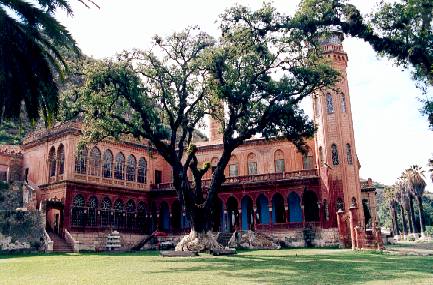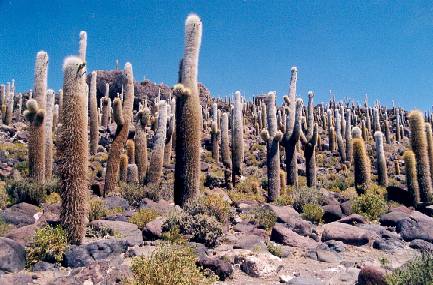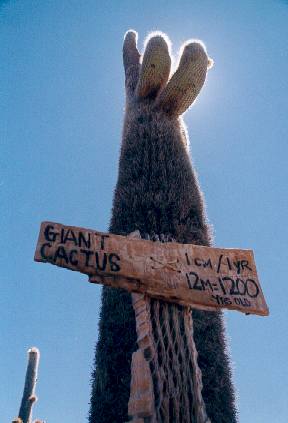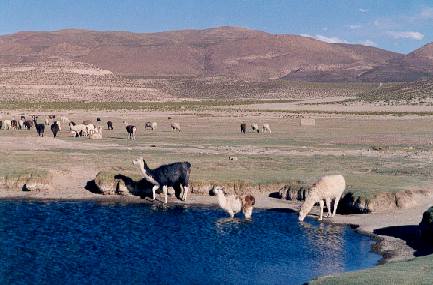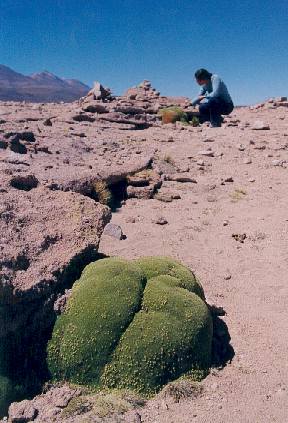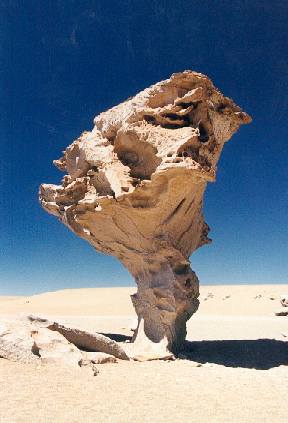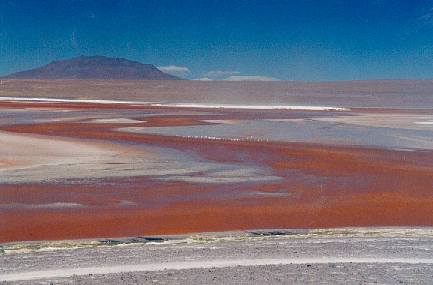Bolivia
26 November 2002: La Paz, Bolivia
Well we've crossed into Bolivia at last. And Back into Peru. And
back into Bolivia again. My passport is going to fill up soon at this
rate!
Copacabana and the Isla Del Sol
We fianlly left Puno on a bus bound for Copacabana in Bolivia.
The Peru-Bolivia border doesn't go straight down the middle of Lake
Titicaca but snags a peninsular on the Peruvian side into Bolivia.
Copacabana is the main town on this peninsular, and the Isla Del Sol
and the Isla De La Luna are Bolivian islands reached by boat from there.
The border formalities are straightforward and we arrived in
Copacabana at lunch time. Copacabana has a famous shrine where bolivians
come to have things blessed, like new cars and little model houses.
They are quite serious about this: they honestly think that the Virgin
of Whatever will intervene and stop them from crashing over a precipice
if they have had their vehicle blessed in Copacabana. This makes the
town quite a destination for Bolivian day trippers. In an effort to
make it less appealing the authorities impose an entrance fee of one
Boliviano (about 10p) for everyone entering the town - even bus
passengers who are passing through on their way to La Paz! Since
they obviously didn't want any more visitors we got straight on a
boat over the the Isla Del Sol.
The Isla Del Sol has an important role in the Inca creation legend.
I forget the details, but it is something like the birthplace of the
four brothers who made their way to Cusco, "navel of the earth".
Anyway there are a couple of bits of Inca ruin to look at. But mostly
it is just a pleasant sunny island in Lake Titicaca where you can
relax for a couple of days, and that's what we did.
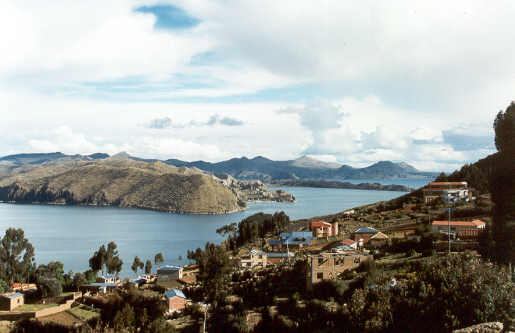
Of course it also has something in common with Amantani and Taquile,
the two islands in the Peruvian half of the lake that we visited a few
days earlier. But Isla Del Sol is quite a bit more developed: they
have electricity from the mainland, for example. But what they all share
is not looking as if they belong on Lake Titicaca. In the afternoon
sun, with donkeys climbing the steep steps up from the port (and ignoring
the odd lama in amongsth them), you could be on a Greek island.
(Christine and I have both just read books set on Greek islands.) When
the clouds come down and the lake looks grey, according to an Irish
guy we met it could be the view from his window in Donegal. But one
difference from either of those places is the view of 6000m+ snow-capped
mountains in the distance.
So after a couple of nights we returned to Copacabana. (And
discovered that the cheeky buggers charge only 9 Bs to get out to the
island, but getting back costs 15. Arrgghh!) Next stop was to be
La Paz, and it should have been a simple bus trip of about three or
four hours. But no! Remember that Copacabana is on a Bolivian
peninsular on the Peruvian side of the lake? Well to get over to
Bolivia proper you have to take a short ferry ride. (And I was quite
looking forward to this ferry ride because you get to see the Bolivian
Naval Base. Bolivian hasn't had any sea for its navy to patrol since
the War of the Pacific.) Anyway it seems that the town where this
ferry crossing is located feels that it isn't getting its share of the
tourist business from Copacabana, so - believe it or not - they have
barracaded the crossing. As if that is going to increase it! So
we had to take the long route: back into Peru and right around the
bottom of the lake.
The journey was quite an adventure. The first collectivo from
Copacabana back to the frontier was relatively unadventurous. Then,
rather than a series of three buses to get to the other border crossing,
five of us decided to share a taxi. Unfortunately the taxi we chose
had a dodgy gearbox and got slower and slower, until we were doing only
about 20 kph. At this point the driver gave up and we transfered into
another taxi for the last 30 km; this driver decided to do the whole
trip at 100 to 130 kph! So we arrived in Desaguadera, did two more lots
of border formalities (they were a bit overworked, due to the extra
people, but still it was fairly painless), walked across the frontier
bridge (it may be the place where the water flows out of Lake Titicaca
towards Lake Poopo, from where it evaporates), and got on a bus to
La Paz.
La Paz
We've not seen much of La Paz yet, but as you come into the city
you get to appreciate its spectacular location. From Titicaca the road
crossed a large flat plain, probably former lake bed, at about 3900m.
The new outskirts of La Paz, including the airport, are up on this plain.
Then suddenly the bus reaches the edge of a cliff and starts to wind
down it round a series of hairpin bends (a bit like the train ride into
Cusco). The city is spread over the sides and floor of a steep canyon,
and to make it even more impressive there is a huge snow-capped
mountain as a backdrop.
We have various mundane things to do over the next day or two, and
we also have to decide what to do next. A trip to the jungle? To the
mountains? To the salt lakes? Stay tuned for the next installment!
1 December 2002: La Paz, Bolivia
New Plans!
We've been in La Paz for a few days and not because we greatly like
it here. There is a Lan Chile office and I have been camped out there
for much of the time trying to sort out my plane tickets for the next few
months.
I realised there was going to be a problem when we were in Cusco.
I went into the Lan Chile office there to ask about a routine date change,
and in the course of the conversation it became clear that there were
going to be problems with my trans-pacific flight from Santiago to Auckland.
This is the only direct flight across the South Pacific that I can use
with my ticket and it is booked solid until the middle of March. Not that
the official "one world explorer" web site admits this: it says that there
are plenty of seats. Anyway, I had the choice of staying in South America
for an extra couple of months, or trying my luck with a waiting list for
a cancellation, or finding an alternative route.
I've gone for the final option. Apart from the Santiago to Auckland
flight the other choices are to go via Los Angeles, or to fly from
Buenes Aires to Sydney, neither of which is possible with my ticket, or
to island-hop, which is mostly possible. So I now have tickets for
flights from Santiago to Easter island, where I'll stay for four days, and
from Easter Island to Tahiti, where I'll stay for a week. Then I´ve had
to buy my own ticket from Tahiti to Auckland.
So now I need to know what to do on Easter Island and Tahiti, so any
suggestions are welcome. Easter Island is actually included in my Chile
guidebook (it belongs to Chile) and I think I can fill my time looking at
the archaeology. But I have no idea what there is to do on Tahiti (though
I do still have my Mexican hammock with me, and I think that it will come
in useful...). Anyone out there been there?
Patagonia for Christmas
So before all of that trans-pacific stuff starts I´ll be spending
some time amongst the mountains in Chile, and with the current timetable
I'll be in Patagonia for Christmas and New Year. I'll just say that again:
"Hiker looking for fun stuff to do in Patagonia over Christmas and New
Year!!!" So is there anyone reading this with any suggestions?
La Paz
As I said at the start most of my time in La Paz has been spent inside
the Lan Chile office, but we have seen a bit of the city and a few of the
museums. The traffic here is totally ghastly and crossing the road is
terrifying. They really do have traffic signals where the cars and the
pedestrians have green lights at the same time (and I don't just mean the
standard U.S. thing of cars that are allowed to go through a red light
as long as they give way). There are two sorts of buses: reasonably clean
far-eastern
minibuses like they have in Peru, and huge old things from the U.S. with
names like FORD, DODGE and CHEVROLET across the front at eye-level. I get
the feeling that these things are about fifty years old, and they belch the
most enormous plumes of black smoke out behind them - as much as a steam
engine. Yuk.
They have a small museum of pre-conquest gold;
there's not a lot of it, certainly less than they have in Costa Rica,
but at least these few scraps excaped the Conquistador's crucible. In
Peru they have nothing. Mostly it is thinly-beaten gold sheets turned into
chest-plates and the like.
Note for Film Buffs
In an effort to escape from the streets of La Paz for a few hours
we took ourselves to the cinema: we saw Amelie, the lovely French film.
Luckily we had both seen it before, as I don't think either of us could
follow either the French soundtrack or Spnish subtitles quickly enough.
Anyway it was in a huge old cinema which had, at some point, been
upgraded to "Dolby Digital" sound. I understand that the criteria for
this are quite strict and it seems that this old place had a bit of a
problem with echos. So they had covered the walls and ceiling with....
six thousand two hundred egg boxes! (That's our estimate anyway.)
Quite a sight.
Tihuanaco
Today we ventured out of the city to the ruins at Tihuanaco. You
probably haven't heard of Tihuanaco, but they were probably as important
as the Incas (and to the Bolivians they are more important!). They
started out as argriculturalists on the Altiplano (high plain) on the
South side of Lake Titicaca a few centuries B.C. They were smart enough
to work the most efficient way to grow stuff in this fairly inhospitable
terrain (nearly 4000m up) and their agricultural surplasses gave them
the resources to build a large city and to expand their teritory to form
a huge empire. They collapsed mysteriously about 1000 A.D., and the
Incas can be thought of as the "Pheonix from the ashes of the
Tihuanacanos" in the way that, perhaps, the Byzantines came out of the
collapse of the Roman empire.
So having collapsed a thouasand years ago there is not as much to
see of the Tihuanacan remains as there is of the Incas from only half
as long ago. And, thankfully, the Bolivians have not been as obsessed
with "reconstructing" the ruins as their Peruvian counterparts. So what
you can see are the remains of two step pyramids, not entirely unlike
the Mexican ones that I saw a few months ago, collapsed into
big earth mounds. Then there are a few "temple" buildings with nicely
made stone walls, in some cases with stonework of Inca or better quality.
One of them has stone bosses in the walls carved in the shapes of heads;
the suggestion is that this superceeded the practice of displaying real
trophy heads from battles.
The nicest artifacts are some carved columns - a bit like stone totem
poles - some of which are in situ in the temples and some of which have
been moved to a site museum. The site museum is excellent, at least
compared to what we have been seeing recently. There are actually two
buildings; one contains smaller things like pots and arrowheads, and
actually has labels in practically all of the cases! It even had a
fairly intellectual display about the technology of bronze manufacture in
the Andees! The other building has the larger bits of carved stone, and
although they are very well displayed they are somewhat lacking in
information, such as where in they site they were found. But generally
it was a much more satisfactory experience than the Inca ruins around
Cusco (though on a smaller scale). Thumbs up to the Bolivians!
So tomorrow we're heading on to Cochabamba, with is a seven hour
bus trip South from here. More news soon.
4 December 2002: Cochabamba, Bolivia
Cochabamba
In most respects Cochabamba has been a pleasant change from La Paz.
It's a bit warmer here - we're a bit lower down, though still well above
the level of the jungle - and the place is a bit more peaceful. You can
cross the road without thinking that you're taking your life in your
hands every time. Architecturally it's colonial, with a couple of
nice plazas with big shady trees and arcades, not unlike some of the
places I visited in Mexico. And it's clearly a relatively afluent place
(and I hope the wealth isn't all from Coca production and Nazi Gold).
On the down side, I got poisoned by something. Probably a plate
of goulash from an expensive tourist restraunt. (Christine says, "If
there was one thing I could say to the Bolivian People it would be
'Now Wash Your Hands'".) So Christine has seen the tourist attractions
while I have been recovering. The main one is a palace built in the
1920s by a "tin barron" in the style of Versailles with a replica of
the Sistene Chapel in the attic!
So now I'm mostly better and we're heading to Sucre. It is
Bolivia's capital-in-name-only (everything apart from the supreme
court moved to La Paz yonks ago). And it's famous for its weaving...
McDonalds
Sadly we arrived in Cochabamba a day too late to witness history
in the making. A few weeks ago MacDonalds announced that they were going
to close down in three Latin American and Middle Eastern countries
(see http://news.bbc.co.uk/2/hi/business/2424825.stm). At
the time I didn't know which countries, but it turns out that Bolivia is
one of them, and Cochabamba had one of their three outlets here! I
read about this in a newspaper and then walked a few blocks down the road
to where it used to be: it had closed the night before, but already there
was impenetrable corrugated iron all around it. But the top of a "Big M"
was visible over the top. So that's one blow against globablisation -
but it's probably one fewer food outlet in Cochabamba where they wash their
hands.
7 December 2002: Sucre, Bolivia
Sucre
We're now in Sucre, a pleasant enough place about 2700m up. The flight
here from Cochabamba was excellent - only 35 minutes, but the alternative
was a ten-hour bus ride, and looking down from the windows it was clear
why. Like Cochabamba, Sucre is part way down the slope from the Altiplano
to the Amazon basin. From the air you can see how the rivers have
incised their way down into what was once a high plateaux. Higher up
the ground is quite barren, then in the river valleys almost jungle.
We flew with LAB - Lloyd Aero Boliviano - who claim to be the
world's third oldest airline and are celebrating their seventy-seventh
birthday! Although their first jet aircraft, a 727-100, is still in
service, we were on a slightly newer plane. Their in-flight magazine
claims that when they started in the 1920s "Bolivia had no roads" - a
rather bizzare statement that also ignores the fact that it did have quite
a respectable rail network until quite recently. Now most towns are
joined by good quality roads and coaches have won, as in most of the
rest of the hemisphere.
When we got to the airport we were greted by gleeful-looking taxi
drivers who told us that there were no buses to the centre. Latin American
taxi drivers are, as a group, probably the least honest people I have
met and I didn't believe a word of it (and other people in the airport said
that collectivos go past the airport gates for only 1 Bol). But it turned
out that they were right! It seems that the local authority wants to
pedestrianise - or at least to prohibit buses from - the city centre, and
the bus drivers don't like the idea. They want to be able to continue to
queue their smoke-belching monsters, engines revving, outside our hotel
all evening while a small boy shouts something incomprehensible at the top
of his voice to enticle potential passengers onboard. So to get their
point across they decided to.... blockade the town! Sounds slightly
familiar? Yes, this is the third place we've got to in the middle of
a strike. But luckily this time it only lasted for the day and the place
seems to be back to normal now.
The main attraction here is the weaving. It seems that the traditional
weaving almost died out in the sixties when most of the old textiles were
bought up by merchants for sale to collectors; the weavers then didn't
have any examples on which to base their new work. But a group of
anthropologists saved the day by giving them photos of their old stuff
and setting up a fair trade network and textiles museum in the town.
The museum is excellent: Christine says it is the best museum in
Latin America! There are three main styles that they focus on from
three distinct areas. One shows fantastic creatures, normally in red,
on a black background: they are supposed to be things from the night or
your dreams. Another has a light background and shows scenes of everyday
life. The final style is multi-coloured and, unusually, is done by men.
It uses a combination of motifs including fantasy creatures, based on
pre-conquest textiles. Of course you want to buy one of each but they
take a long time to weave and have "fair" prices to match. But it seems that
the prices still aren't enough to satisfy the weavers: they augment their
income by selling canabis to the museum visitors!
Dinosaur Footprints
The other main attraction here is the dinosaur footprint site. You
take a ghastly old truck (one redeeming feature: it is powered by local
natural gas) a few miles out to the local cement factory where
they have exposed what was once the muddy edge of a lake, now tilted up
at an angle of 73 degrees. We had an excellent guide who was obviously
a real geologist and used a mirror to reflect a spot of sunlight onto the
face to point out the tracks. Some of them are vast round elephant-like
tracks (I forget how big they said they must have been, but certainly
much bigger than an elephant), and others are smaller, faster carnivores
with three or four toes or claws. And as they quarry deeper, more of it
will be revealved! Excellent.
8 December 2002: Sucre, Bolivia
Still in Sucre
We're still in Sucre but will be leaving tommorrow morning to go to
Potosí, the famous city that was once the fourth largest in Christendom
when its mines were producing more silver than the rest of the world put
together.
La Glorietta
Yesterday we went to see La Glorietta, another "Versailles of the
Americas" built in the 1890s by a Tin Baron. It is somewhat run down,
but not totally neglected, and it could even be that some of it is
being restored. It has some lovely guilded ceilings with carved bat motifs
on them, parquet floors that would look great with just a bit of pollish,
three quaint-looking towers and some pleasure gardens. I reckon it needs
a gang of people who know how to plaster and fix roofs to come and
spend a week's "working holiday" on it.
Tarabuco
Today, for a change, we went a bit further afield to Tarabuco.
Guess what. It has a famous market on Sundays, full of weaving....
The journey there was quite interesting. We were supposed to go on
a tourist bus organised by the place where we were staying, but by ten
the previous night it hadn't got back from that day's excursion, so it was
cancelled. So we ended up sharing a taxi with six Bolivians. It took
me some time to work out exactly what was peculiar about the vehicle:
although the driver was sat behind the steering wheel on the left hand side,
the dashboard (speedo etc) was in front of the passenger on the right
hand side!!!! Yes, this was an imported second-hand Japanese car that
had been "converted" for left-hand-drive operation, moving only the most
important bits!
Anyway the drive - about and hour and a half - progressed uneventfully,
and the driver was actually quite good by recent standards, until we heard
the distinctive hiss of a flat tyre. Oh no we thought, now we're going to
have to wait at the side of the road for hours until they can fix it or
some overloaded lorry turns up that we can clamber on board to finish the
journey. I was even more pessemistic when we realised that there was a
spare wheel but no jack. But no! These Bolivians aren't the sort of wimps
who need a mechanical advantage to lift a car. A suitable large rock was
selected from the side of the road and three people, two of them random
passers-by, lifted the car up while the driver put the rock underneath.
The wheel was changed in no time and we finished the journey without further
incident.
The market was interesting. Most of the stuff that was for sale was
old: ponchos, mantas and the like that presumably people have got down from
the attic now they know that tourists like them. There is quite a range
of designs, and it is likely that quite a lot of them specific to
particular small villages or areas where weaving has since died out.
The three or so styles that you can buy newly-made are probably only the
tip of the iceberg of what existed fifty or a hundred years ago. Anyway,
we made a few purchases....
10 December 2002: Potosí, Bolivia
Potosí
I am writing this in what claims to be the Highest Cybercafe In The
World - 4000m up in the Andees.
We're spending a day in the historical city of Potosí, whose fame
depends on the enormous silver deposits that have been mined in its
mountain since shortly after the conquest. The Spaniards, in their
insatiable desire for precious metals, enslaved the enitre male population
of "greater Peru" to work in Potosí's mines for some proportion of the
time. The city grew to be the largest in Chirstendom after London, Paris
and Seville - if you can really call it part of Christendom since the
miners still very actively worship pre-conquest deities, and even the
Devil, to whom the say that everything under the ground belongs.
Here is a photo of the hill, Cerro Rico, that the mines are underneath.
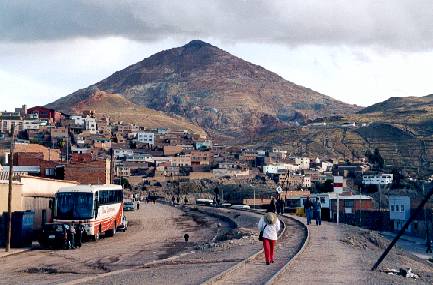
The mines are still actively worked, though other metals are now
more important than silver. The conditions are utterly attrocious and the
life expectency of a miner is 42 years, mainly due to silicosis. Of
course they are not slaves any more, so why do they do it? Although
Bolivia is a poor country there are clearly better options open to them.
I can only
imagine that it is the lottery player's skewed perception of chance:
every miner imagines that they will be the one to find some rich vein that
will make their fortune.
Anyway, all these old riches have given the city some nice old
architecture (big old doorways are the main things you see from the
street) and plenty of churches. This afternoon we went on a tour of the
Museo Santa Teressa, a former convent of a closed order.
At its largest it was built
around eighteen courtyards, but as the city's riches declined it
contracted to only three. Finally, within the last few decades, the
nuns moved into a corner of the site and the majority was turned into
a museum - and a very good one.
Of course it is full of religious art, of which we have seen lots
recently. But here much of it had been recently restored,
the frames repaired and
re-guilded and the pictures cleaned, making them much more striking.
Apparently when a girl, normally from a noble family, was sent to the
convent she took a "dowry". This could be cash or the equivalent value in
religious art, and this is where it all came from. We saw one set of
vestments that had been made by a novice from the clothes that she
arrived in: of course she wore only a habit as a nun. Another thing
(what is the word for a religious apron?) was made with silver and gold
thread and weighs five kilograms!
The building itself is interesting, as are the courtyards which are all
full of plants and a three hundred year old apple tree that still fruits.
But probably most interesting of all was to see the way of life that the
nuns lived until very recently. They have a lovely old kitchen, and you
can see a reconstructed cell. But most interesting was to see how they
communicated with the outside world - or rather how they failed to
communicate with it. They had a revolving thing where
goods could be put on one side by a tradesman and spun around to enter the
convent, with money going back in return.
Then there were the arrangements for nuns to communicate with
their parents, who were allowed to come for an hour a month. They
were separated by a five-foot-thick wall with a large hole cut in it.
On the outside this hole had a grid of wrought iron bars with spikes
pointing out from them. On the inside there was a thick black curtain.
So the families could talk to, but not see, their daughters. This carried
on until, can you believe it, 1965. After "Vatican II" in 1965 they
replaced the black curtain with a piece of glass so they can see each other.
I do wonder what we would think if this was going on in Afghanistan or
somewhere else where human rights are in the West's spotlight, rather than
in a "Christian" country.
Anyway, it was an excellent visit; interestingly one of the best
museums in Cusco was also a former convent so maybe it's something worth
looking out for.
Miracle Drug Discovered!
I am pleased to report that the "Wonder Miracle Drug" Ciprofloxacin
has cured all my recent digestive ills. This stuff is great: it will
cure everything from Anthrax to Diarrhea. Visitors to Bolivia, take it
from day one and you'll be fine!
Uyuni
Tommorrow we're off to Uyuni, next to the world's largest salt lake.
All being well in a few days we'll be across the other side in Chile's
Atacama desert. More news then.
12 December 2002: Uyuni, Bolivia
Well we finally got out of Potosí. It took longer than it should
have done: the bus company signs all claim to have buses to Uyuni at
1130 and 1830, but when you ask it seems that only the evening buses
exist. So we spent another day trying to find anything open to visit
in Potosí: the only bit of industrial archaeology, an old water-powered
ore crushing works, has been turned into a restraunt; the Calcha
textiles exhibition is closed until further notice; the museum of
regional costumes (we were getting desperate by this point) was closed
for cleaning, and the University Museum seemed to have a lecture going
on in it! We did get to look around the Casa de Moneda ("coin house"),
where the silver was cast into ingots and turned into coins. It is an
impressively large old building, apparently the largest in the New World
at the time, with some interesting old machinery; they had huge
mule-powered mills for flattening the cold silver ingots into strips from
which the coins were cut.
Anyway we eventually boarded a bus for the six hour trip on
an unsurfaced road to Uyuni. We survived, but it was not very pleasant -
lots of vibrations. And it would have been nice to see the view. (We
found out after we got to Potosí that there is actually still a train
to Uyuni - probably much more comfortable than the bus ride, but sadly
only once a week, and not on a convenient day for us.)
Uyuni
Uyuni is a small place with a bit of a wild west feel to it. It is
in the middle of a big flat plain with a few hills in the distance that
seem to float above the ground due to the heat. Having booked our jeep
trip for tommorrow there was not much to do this afternoon, so taking the
advice of our guidebook we went to visit the train graveyard. You might
think that a poor place like Bolivia would melt down its old bits of
train and turn them into concrete reinforcing rods (used here as a universal
construction material), but it seems that they
are happy to park them in the desert and let them rust.
It is a two kilometer walk from the town center through the almost-desert
landscape. It should be full of drought-resistant plants like cactuses
and other small spikey things, but these all have the characteristic that
stray plastic bags stick to them, and since the Uyunians dispose of their
rubbish by chucking it in the street, the desert now blooms with
millions of plastic bag bushes. Anyway we got to the graveyard, and
some locals
with a sense of humour have turned some of it into bits of art. One of the
old locomotives is annotated with the slogan "Necesito un mecanisto con
experencia" (Experienced mechanic required).
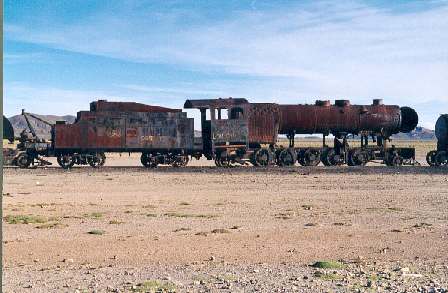
So we're off tommorrow to see the salt lake, and will be in Chile in
three days.
17 December 2002: Antofagasta, Chile
We've just arrived in Antofagasta, on the Chilean coast. This is the
first time we've been at sea level for weeks and weeks - there is a lot
more atmosphere here and it is hot too.
The Salar de Uyuni
We spent three days in a Toyota Landcruiser getting from Uyuni in
Bolivia's Altiplano to San Pedro de Atacama in Chile. The trip passes
through some extraordinary landscapes and was well worth doing, though
it is a shame that the company we went with were so dodgy.
This part of the Andees is very dry and much of the land drains into
inland evaporation basins rather than the oceans. For example, the
outflow from Lake Titicaca flows into Lago Poopo from where it evaporates.
Some of these lakes have water in all year - albeit very salty water.
Others are dry salt lakes during the dry season that get a bit soggy when
the rains come. The Salar de Uyuni, which we crossed on the first day,
is in the latter category. It is an enormous expanse of white salt for
as far as the eye can see (and quite a bit further). The locals dig it
up and sell it, and have probably been doing so for hundreds of years.
The heat makes odd things happen at the horizon, and from a distance it
looks as if their piles of sand are hovering in mid air!

In the middle of the salt is the Isla Del Pescado, so named because
its profile from a distance looks a bit like a fish (hmmm). This was
our lunch stop and it is a fascinating place because it is covered in
the most enormous cactuses, the tallest about 12m tall and said to be 1200
years old.
Lagunas
It took a few more hours driving over the smooth salt to leave the
Salar, and the subsequent tracks were much rougher. We spent the night
in a tiny place called San Juan which seems to exist mainly because it
has a water hole where their llamas can drink.
Then on the second day we started off with a rough drive through
the desert, our discomfort briefly eased by a stop where we saw these
very odd plants that look like they should be soft as moss but are actually
rock hard.
Then we
visited a sucession of salt water lagoons full of flamingoes. Apparently
there are three different sorts of flamingoes but they aren't easy to tell
apart. Apart from the birds the other wildlife to see are the vicuñas,
the wild camelids from which the early humans bred llamas. Vicuñas are
much less stocky than llamas which are clearly much more suitable as
beasts of burden.
Finally we crossed some more high-vibration desert, including a stop
to see this "stone
tree", carved by the wind. (And you can believe that as it was quite
windy when we were there!)
Many of the lagunas are brightly coloured - red, green or yellow,
depending on how much salt is in them and what colourful bacteria can put
up with the conditions. This is Laguna Colorado.
We spent the final night in the middle of nowhere before making an
early start to see the geothermal attractions of the final day.
Boiling Mud!
Apparently this looks best early in the morning, so we set off at
five AM! There are a few steam vents (which they call geysirs, but
aren't) and some boiling mud pots, very much like the ones I saw in
Iceland. Then we had breakfast at a hot spring before driving almost
the last leg to Laguna Verde. This salt water lake is green for some
reason and reflects Volcan Licancabur, a 5900m peak on the Chilean
border.

Generally we stopped only for a few minutes at each of these points
of interest. We spent much more time looking out of the windows of our
Landcruiser at the passing desert. It would have been very interesting
to know something about the geology, but we had only a driver, not a guide.
I think that the desert is mostly volcanic material, probably from
erruptions eons ago. It could be the sort of place where you can find
meteorites! Quite a few of the hills had bright yellow sulphurous
patches on them, but only one showed any signs of current activity: a
spurt of steam from the side.
Into Chile
The Bolivians actually have a frontier post where you get your
passport stamped. The Chileans are happy for you to wait until you get
a couple of thousand meters lower down before they process you. The
frontier pass is at 4480m, making it higher than the high point of the
Cusco-Puno railway and so the highest point on the trip so far.
On the Bolivian side the nearly-6000m peaks rise from a 4000m plain.
On the Chilean side they rise from a 2500m plain, making them much more
impressive! We drove down from the pass to the town of San Pedro de
Atacama following old lava flows from Volcan Licancabur, which sticks up
with a classic volcano shape. Finally we got to the border control.
As well as conveying tourists like us the road also leads to a pass into
Argentina, and we had seen trucks taking new cars to Paraguay. The
frontier was not a good introduction to the country. They made us wait
for three quarters of and hour, and then did a thorough job of
looking through everyones' rucksacks. They made me unseal and open
up my first aid kit which has been carefully packed up for years. But
if anyone really wanted to smuggle in some coca leaves, or fresh fruit
and veg, or whatever it is they're looking for, they need only put it at
the bottom of their bag.
Dodgy Tourismo Desierto
Our guidebook has a comment like "generally tour operators in
Uyuni are terrible" and gives an address to complain to before going on
to mention some less-bad companies. But this book has proved incredibly
unreliable recently and we got the firm impression that things had
improved recently. This turned out not to be the case.
Since their customers leave the country at the end of the trip
the tour operators know that there is little chance that they will be
able to complain effectively. So they promise all sorts of things when
you sign up and then fail to deliver them.
In our case, I have a document signed by Tourismo Desierto where
they say that the price we paid includes entrance to the two national parks,
free drinking water, and various other things. But when we actually got
to the Isla Del Sol our driver (Octavia) refused to pay up and we had to
pay again ourselves. The same thing happened at the national park office
for the Lagunas, and we had to buy our own drinking water (a rare commodity
in the middle of a desert). As well as the money that we lost it really
made the trip feel unpleasant: we had to sit for hours in a vehicle with
a man who had robbed us and who we knew was going to get away with it.
(The is a small police presence in the area but they all seem to be old
friends of his, so going to them didn't seen like a promising idea.)
Anyway I will be writing to the complains address that our guidebook
gives. I'm also hoping that maybe this mention of Tourismo Desierto of
Uyuni (and their partners-in-crime Pamela Tours with whom the vehicle was
shared) will alert others to these particular crooks.
1 January 2003: El Calafate, Argentina
New Photo
Dad has been busy with his scanner and has stitched together
this panoramic view of Laguna Colorado, from the end of our Bolivian
desert trip.
You can see a bigger version by clicking here:
http://chezphil.org/rtw/images/Panarama.jpeg
© 2002 - 2003


